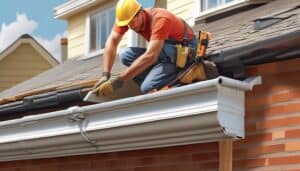As homeowners, we are often tasked with maintaining the integrity of our dwellings, and one key aspect of this responsibility lies in the realm of gutter replacement.
This task, while seemingly straightforward, is fraught with critical decisions that can significantly impact not only the aesthetic appeal of your home but also its structural longevity.
From assessing the condition of your current gutters, making an informed choice about the appropriate material, and understanding the different gutter styles, to selecting qualified professionals for the job, each step demands careful consideration.
Post-installation maintenance too, cannot be neglected.
Let’s navigate through these aspects one by one, to equip you with the knowledge needed to make the best gutter choices for your home.
Key Takeaways
- Evaluate the current state of your gutters by assessing their lifespan, looking for damage indicators, and checking for overflow during rainstorms.
- Consider factors such as durability, maintenance requirements, aesthetic appeal, and cost when choosing the right gutter material.
- Understand the differences between K-style and half-round gutters and choose a style that complements your home’s architectural design.
- When hiring professionals, look for valid accreditation, consider their training and adherence to industry standards, and assess their reputation for reliable work.
How to Assess Your Current Gutters?
Before embarking on the journey of replacing your gutters, it’s essential to carefully assess the current state of your home’s existing gutter system to identify any structural or functional issues. This evaluation should ideally incorporate a consideration of the gutter lifespan and the presence of any damage indicators.
The gutter lifespan varies according to factors such as the material used, climatic conditions, and maintenance practices. For instance, steel gutters typically last about 20 years, while copper ones can last over 50 years. Thus, if your gutters have reached their expected lifespan, you might want to consider replacing them even if they appear to be in good condition.
Damage indicators to look for during the assessment include visible cracks, holes, rust spots, and sagging or warping of the gutters. Water stains on the walls or flooded basements are other signs that the gutters may be malfunctioning. Similarly, if you notice that the gutters are overflowing during a rainstorm, it’s a clear sign that they are not effectively channelling water away from your home.
Thus, a thorough evaluation of your gutter system is the first step towards ensuring the structural integrity of your home.
How to Choose the Right Material?
When it comes to selecting the ideal material for your new gutters, several factors such as durability, maintenance requirements, aesthetic appeal, and cost should be diligently considered to ensure the longevity and functionality of your gutter system. Material longevity is paramount, as you want your investment to last for many years.
To aid in your decision, consider the following table which provides a cost comparison and outlines the advantages and disadvantages of popular gutter materials:
| Material | Advantages | Disadvantages |
|---|---|---|
| Aluminum | Lightweight, resistant to rust, and available in various colours | Can dent easily, but may not be strong enough for heavy snowfall |
| Copper | Extremely durable, aesthetically appealing | Expensive, and requires professional installation |
| Steel | Very strong, can handle heavy loads | Can rust over time, heavy |
| Vinyl | Inexpensive, easy to install | Can become brittle in cold weather, and not as durable |
| Zinc | Long-lasting, develops a protective patina | Expensive, and requires professional installation |
Choose wisely, considering both upfront costs and ongoing maintenance expenses. The right material will not only enhance your home’s exterior but also provide reliable protection against water damage. It’s a balance of practicality, durability, and aesthetics.
What Are the Different Gutters Styles?

Equally important to the material selection in your gutter replacement project is understanding the various gutter styles available and their respective benefits and drawbacks. Gutter styles can significantly impact both the functionality and the aesthetics of your home’s exterior.
There are two primary styles to consider: K-style and half-round gutters. K-style gutters, which have flat bottoms and backs, are favoured for their modern look and increased water capacity. Half-round gutters, with their semicircular design, offer a more traditional appearance and are often found on older, historic homes.
Consideration of gutter aesthetics should not only focus on the style but also on how it complements your home’s architectural design. A mismatch can detract from your home’s curb appeal.
In terms of cost comparison, K-style gutters tend to be less expensive due to their widespread use and the simplicity of their design, making them easier to install. Half-round gutters, while potentially more aesthetically pleasing to some, can be costlier due to their unique shape requiring specialized installation.
Understanding the different gutter styles and their implications on aesthetics and costs can greatly assist in making an informed decision for your gutter replacement project.
What Should You Check for When Hiring Professionals?
Once you have a solid understanding of the various gutter styles and their respective costs, the next crucial step in your gutter replacement project is to engage the services of a highly qualified professional. This is pivotal to ensure the longevity and efficiency of your new gutter system.
It is essential to look for gutter replacement professionals with valid accreditation. This certification serves as a guarantee of their competence and adherence to industry standards. The cost implications of hiring such professionals might be higher, but the investment ensures a high-quality installation that can save significant repair and maintenance costs in the long run.
To evoke emotion in the audience, consider the following table that compares accredited professionals with non-accredited ones:
| Characteristics | Accredited Professionals | Non-Accredited Professionals |
|---|---|---|
| Training | Extensive, certified training | Limited or no formal training |
| Quality of Work | High, according to industry standards | Variable, not always up to standard |
| Cost Implications | Higher initial cost, lower long-term expenses | Lower initial cost, potentially high long-term expenses |
| Reputation | Generally positive and reliable | Mixed, can be unreliable |
| After-Service | Often offer guarantees/warranties | Rarely offer guarantees/warranties |
What Are the Essential Maintenance Tasks After Installation?

Ensuring the longevity and optimal function of your newly installed gutter system hinges on diligent maintenance practices post-installation. The importance of regular checkups and cleaning cannot be overstated.
Here are four essential measures to sustain your gutter’s condition and performance:
- Post-installation checkups: Schedule regular inspections with a professional to identify and rectify any potential issues early. This proactive approach can mitigate damage and costly repairs.
- Gutter cleaning tips: Clean your gutters at least twice a year. Remove leaves, twigs, and other debris that can clog the system and cause water damage. Use a ladder, wear gloves, and be sure to have a secure footing.
- Downspout Maintenance: Equally crucial, ensure that downspouts are clear and efficiently directing water away from your home’s foundation. Install downspout extenders if necessary.
- Gutter Guards: Consider installing gutter guards. They can significantly decrease the frequency of cleaning by preventing debris from entering the system.
Adhering to these maintenance practices will help safeguard your investment, ensuring your gutter system continues to protect your home effectively for many years.
Do Bird Spikes Help in Preventing Gutter Damage?
Bird spikes for gutters are an effective solution for preventing gutter damage caused by birds. These spikes discourage birds from landing and nesting on gutters, thus reducing the risk of clogs and damage. Installing bird spikes can help homeowners protect their gutters and avoid costly repairs.
What Should I Consider When Deciding Between Gutter Repair and Gutter Replacement?
When deciding between gutter repair and gutter replacement, it’s essential to consider the benefits of gutter replacement. While gutter repair may offer a quick fix, replacement can provide long-term solutions, improved functionality, and increased home value. Evaluate the condition of your gutters and weigh the benefits of gutter replacement carefully.
Frequently Asked Questions
Conclusion
In conclusion, replacing gutters necessitates a comprehensive evaluation of the existing system. This evaluation should include determining the current condition of the gutters and identifying any issues that need to be addressed.
Once the evaluation is complete, the next step is to select appropriate materials for the replacement gutters. This may involve considering factors such as durability, aesthetics, and cost.
Understanding the various gutter styles available is also important. Different styles may have different features and benefits, so it’s essential to choose the style that best meets the needs of the home and its surroundings.
After selecting the materials and style, it is crucial to hire skilled professionals to handle the installation process. Proper installation is necessary to ensure that the new gutters function effectively and last for a long time.
Finally, post-installation maintenance is crucial to ensure the longevity and functionality of the new gutters. This may involve regular cleaning and inspections to prevent clogs and address any potential issues that may arise.
Overall, a thoughtful and judicious approach to gutter replacement can significantly enhance a home’s exterior. It can safeguard its structural integrity and ensure efficient water drainage, making it a worthy investment.






